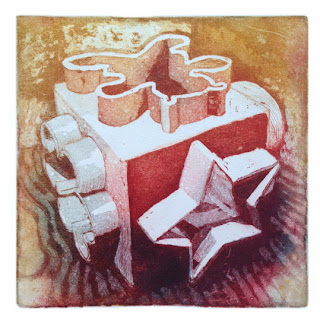This is a technique which has some interesting results. It is the application of gum arabic to a layer of BIG (Baldwin's Intaglio Ground) resist.
1. Apply BIG in several thin layers and heat until cured (it becomes very hard like a varnish)
2. Allow to rest for 45mins to 1hour.
3. Lightly dust with talcum powder.
4. Paint on gum arabic, preferably in a thick layer to make it stronger. Thick layers make bigger cracks but less of them, thinner layer makes more cracks which are thinner.
5. The plate is heated on a hot plate, the gum shrinks back exposing the resist underneath. It is very unpredictable, and you can end up exposing too much resist.
6. Carefully take off the resist with cotton wool and white spirit or Lincoln Wash.
7. Carefully wash off the gum arabic with water.
8. Etch the plate. You can do an aquatint before this process, but I didn't, not wanting to spend too much time on it.
9. Clean up the plate and it's ready to print.







